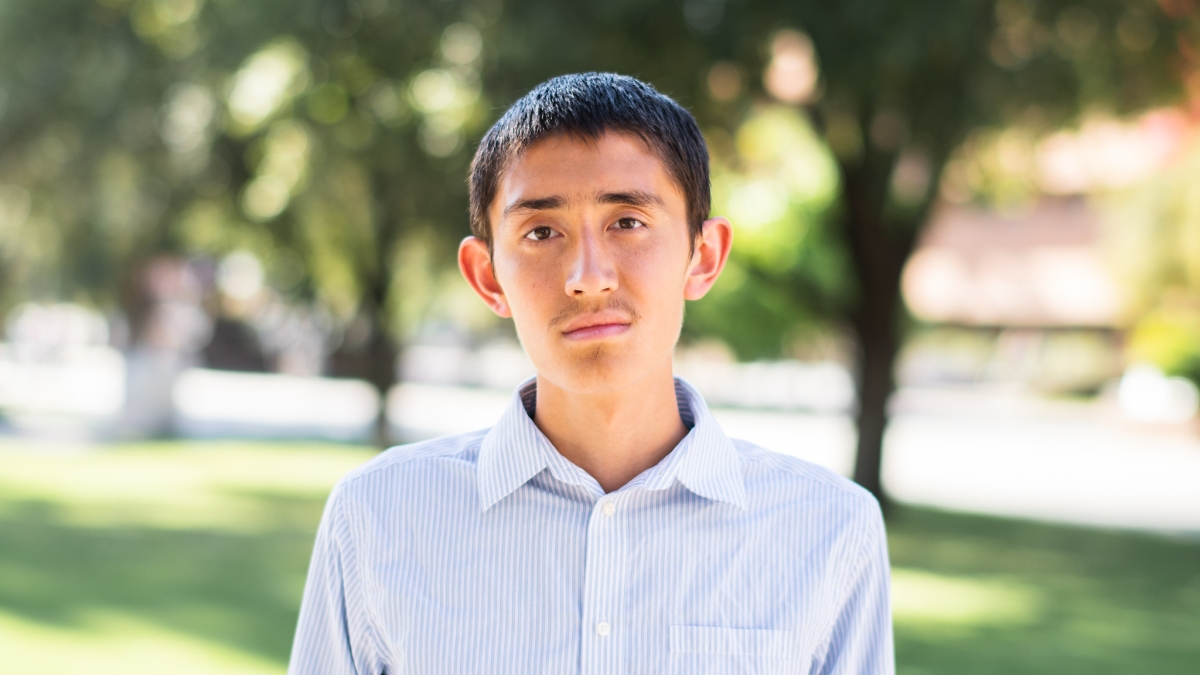Alaska to Arizona: ASU grad finds his intellectual home

Brian Sweeney is among the first students to complete the applied mathematics degree program in the College of Integrative Sciences and Arts at ASU Polytechnic campus.
Editor’s note: This is part of a series of profiles for spring 2019 commencement.
What college is right for you? What will you major in? These are difficult questions and choices for any 18-year-old. But when Brian Sweeney graduated from high school in Anchorage, Alaska, he had a feeling the answers to both were 3,600 miles away from home, at ASU.
Sweeney, who is graduating in May 2019 with two bachelor’s degrees — one in applied mathematics in the College of Integrative Sciences and Arts and one in economics in the College of Liberal Arts and Sciences — said he knew he wanted to study mathematics since high school, taking interest in the various ways math can be used in the world.
So he chose to major in applied mathematics, one of the newer degree programs at ASU Polytechnic campus, and here Sweeney found his second home.
The smaller college environment at the Polytechnic campus allowed him to focus and have close connections with professors and colleagues. Sweeney also competed on the College of Integrative Sciences and Arts Academic Bowl team this spring.
Coming in, he knew that even though he was based at ASU’s Polytechnic campus he’d have all the benefits of a large research university.
“I chose ASU because it has ample research opportunities for undergraduates and lots of resources” Sweeney said. “The large number of faculty also helped make it easier to find professors with similar research interests as me.”
In that environment, Sweeney discovered his second passion — economics.
“When I took my first college-level economics course I realized this needed to be a part of my studies,” he observed. “Learning more about the models of the economy and connecting that directly to the applications of mathematics has been a perfect combination for me.”
ASU Now asked Sweeney about his experiences at the university and his plans for the future.
Question: What’s something you learned while at ASU — in the classroom or otherwise — that surprised you, that changed your perspective?
Answer: I learned that the human experience has a diverse history of different ways of thinking and that the true development of modern science and technology has come about only very recently. Many of the advancements in thinking and science were originally considered impossible and people were punished for their ideas. This surprised me and made me realize how important it is to encourage people to express their perspectives and share their findings without fear of ridicule. New ideas need to be heard and considered before being dismissed, otherwise we may miss out on critical scientific advancements.
Q: Which professor taught you the most important lesson while at ASU?
A: As an introvert, in-class discussions were challenging for me, but Dr. Thomas Martin taught me that discussions are less about the amount you speak and more about the quality of your insights. He taught me to focus on key insights that would contribute to the discussion and to not be afraid to express my ideas, despite fear of criticism.
Q: What’s the best piece of advice you’d give to those still in school?
A: For those still in school, don't give up, and don't be too hard on yourself. Everyone has missteps and makes mistakes at some points, but what is important is to learn from these setbacks and work to do better next time. Learn from mistakes but do not let them impede your progress.
Q: What was your favorite spot on campus, whether for studying, meeting friends or just thinking about life?
A: My favorite spot on campus was probably the Sun Devil Fitness Complex, where I could lose myself in my runs, think about life and leave feeling refreshed. Long-distance running helps me relax and feel happier and the Sun Devil Fitness Complex gave me a convenient place to achieve that on-campus.
Q: What are your plans after graduation?
A: After graduation, I plan to attend graduate school and obtain a PhD in mathematics. Afterward, I want to work in mathematical modeling or in an economics-related position where I can apply my mathematical background.
Q: If someone gave you $40 million to solve one problem on our planet, what would you tackle?
A: I would put it toward helping the environment and keeping it clean. My efforts would focus on a few specific issues to help protect our ecosystems, such as improving access to recycling services and preventing air and water pollution.
Written by Sophia Molinar, class of 2019, Walter Cronkite School of Journalism and Mass Communication; student marketing assistant, College of Integrative Sciences and Arts
More Science and technology

SPARCS mission spacecraft bus delivered to ASU for final assembly
The Arizona State University team that is building the NASA-funded Star-Planet Activity Research CubeSat, or SPARCS, cleared a…

Associate professor shares her journey from NASA to ASU
From leading space missions to designing and building spaceflight hardware and training students in space science and engineering…

Famed systems engineer inspires ASU to tackle global problems
“Providing great talent with great opportunity can make a great difference.” Such was a key part of the message delivered by G.…